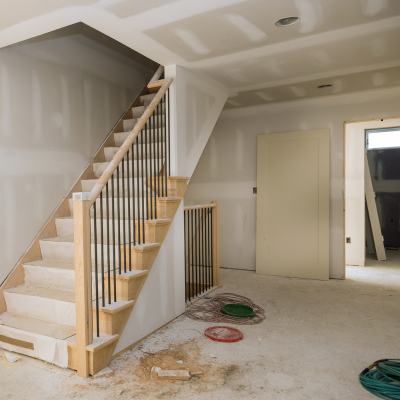Basement Remodeling vs. Basement Renovation vs. Basement Finishing: What’s the Difference?
If you’re considering a basement project, you may have come across terms like basement remodeling, basement renovation, and basement finishing. Though these terms are often used interchangeably, they actually refer to different types of projects, each with unique goals, processes, and costs. Choosing the right type of project for your basement can save you time, money, and ensure the end result meets your needs. In this guide, we’ll explain the differences between basement remodeling, renovations, and finishing, and help you determine which is the best fit for your space.

What is Basement Finishing?
Basement finishing is the process of converting an unfinished basement into a livable, functional space. If your basement has concrete floors, exposed insulation, or minimal lighting, it is likely unfinished. Finishing your basement means adding all the elements necessary to make it usable, from installing walls and flooring to adding insulation, lighting, and ventilation.
What’s Involved in Basement Finishing?
Finishing a basement is a multi-step process that involves several critical steps, each designed to make your basement as comfortable and functional as the rest of your home.
- Insulating Walls and Ceilings: Insulation helps regulate temperature and prevents drafts, making your basement more comfortable. Proper insulation also enhances energy efficiency, which can reduce your heating and cooling bills.
- Adding Drywall and Ceilings: Installing drywall and ceiling tiles or drywall on the ceiling creates a smooth, finished surface. This step covers up exposed insulation, pipes, and wiring, giving the space a polished appearance.
- Flooring Installation: Flooring choices for basements vary widely, from carpet to vinyl or tile. Each material has its benefits, but waterproof and durable flooring options are particularly well-suited for basements where moisture may be a concern.
- Electrical and Lighting: Proper wiring and lighting make the space usable. Recessed lighting, track lights, or ceiling lights are common in basements, especially in rooms without windows.
- Ventilation and Heating Systems: Proper ventilation and heating are essential for comfort. This may involve adding ductwork or space heaters to ensure the basement temperature matches the rest of the house.
Why Choose Basement Finishing?
Basement finishing is ideal if you want to increase the usable square footage in your home. It’s an excellent option for homeowners looking to add a family room, playroom, or even a home gym. With basement finishing, the goal is typically to create a space that flows with the rest of the house, making it a more comfortable, livable area.
Advantages and Disadvantages of Basement Finishing
Advantages:
- Adds to your home’s overall square footage, which can increase its value.
- Provides a warm, comfortable space that can serve as an additional living area.
- Generally less costly than a remodel since it does not require structural changes.
Disadvantages:
- Limited flexibility for creating highly customized spaces.
- Moisture control and insulation can add costs if not managed properly.

What is Basement Remodeling?
Basement remodeling is typically a more extensive project than basement finishing. If your basement is already finished but doesn’t meet your current needs, remodeling may be the right choice. Remodeling involves redesigning or altering the layout to make it more functional or aesthetically pleasing.
What’s Involved in Basement Remodeling?
Remodeling a basement can vary widely based on the homeowner’s goals. Common steps include changing the layout, adding specialized rooms, or updating finishes.
- Redesigning the Layout: Changing the floor plan is one of the most common reasons for remodeling. This might involve creating separate rooms, adding storage areas, or rearranging existing spaces to maximize usability.
- Adding New Rooms or Features: Homeowners might choose to add a bathroom, kitchenette, or even a home theater during a remodel. Each addition requires specific infrastructure, such as plumbing for bathrooms and kitchens or soundproofing for a theater.
- Upgrading Flooring, Lighting, and Finishes: In remodeling, new flooring or lighting might be chosen to create a more modern look. Upgraded finishes such as trim, paint, and cabinetry can add style and functionality.
- Adding Built-In Features: Custom shelving, entertainment centers, or bar areas are popular options in remodeled basements. These features add both value and functionality, making your basement unique to your lifestyle.
Why Choose Basement Remodeling?
Remodeling is a great choice if you already have a finished basement but want to improve its design or function. A remodel allows you to add highly personalized features and turn your basement into a specific type of space, such as an entertainment area, gym, or even a small apartment.
Advantages and Disadvantages of Basement Remodeling
Advantages:
- Provides flexibility to create a custom space that fits your lifestyle.
- Adds value to your home by increasing its functional variety.
- Often results in a more luxurious or specialized basement design.
Disadvantages:
- More expensive than finishing due to structural and customization work.
- Typically requires permits and inspections, which can extend the timeline.

What is Basement Renovation?
Basement renovation focuses on restoring or updating parts of an existing basement. Unlike remodeling, which changes the layout or adds new features, renovation typically involves updating or repairing elements in the existing space. Renovations are ideal for homeowners looking to refresh the basement or fix specific issues like outdated flooring or water damage.
What’s Involved in Basement Renovation?
Renovation focuses on improving or restoring existing elements, including:
- Repairing or Replacing Flooring: Damaged or worn flooring is common in older basements. Replacing carpet with vinyl, tile, or other waterproof materials can refresh the space and prevent future issues.
- Updating Electrical and Plumbing Systems: Older basements may have outdated wiring or plumbing that doesn’t meet current codes. Updating these systems improves safety and functionality.
- Waterproofing and Insulation: Moisture can be a significant issue in basements. Adding waterproofing, such as drainage systems or waterproof membranes, protects your investment and enhances comfort.
- Repainting or Refinishing Walls: Fresh paint or new wall treatments, such as paneling or wainscoting, can brighten the space and make it feel more inviting.
Why Choose Basement Renovation?
If your basement is already functional but needs some updates, renovation is a cost-effective way to make improvements. Renovations are typically less intensive than remodeling or finishing, focusing on repairing or modernizing existing features.
Advantages and Disadvantages of Basement Renovation
Advantages:
- More affordable than remodeling or finishing since it targets specific updates.
- Enhances the appearance and usability of an existing space.
- Typically quicker to complete, with less disruption to the home.
Disadvantages:
- Limited to improvements rather than major changes.
- Does not allow for structural or significant layout alterations.
Key Differences Between Basement Finishing, Remodeling, and Renovation
Now that we’ve covered each type of project, let’s summarize the main differences between basement finishing, remodeling, and renovation.
| Project Type | Goal | Common Steps | Best For |
|---|---|---|---|
| Basement Finishing | Converting an unfinished basement | Insulation, drywall, flooring, lighting | Adding basic, livable space |
| Basement Remodeling | Redesigning a finished basement | Layout changes, adding rooms, custom features | Customization for specific uses |
| Basement Renovation | Updating existing features in a finished basement | Flooring repair, electrical upgrades, waterproofing | Refreshing and restoring a functional space |
Choosing the Right Option for Your Basement
Deciding which option is best for your basement depends on your current setup, goals, budget, and timeline. Here’s a quick guide to help you make the right choice:
- Assess Your Needs: Determine whether you need to create a livable space from scratch (finishing), customize an existing space (remodeling), or simply update and repair what’s already there (renovation).
- Set a Budget: Each project type has different cost ranges. Basement finishing can be less costly than remodeling, which involves more structural work and custom additions. Renovations are typically the least expensive, as they focus on updates and repairs rather than layout changes.
- Consider Your Timeline: Finishing or remodeling a basement may take several weeks or months due to the complexity of the work, permitting, and inspections. Renovations, however, are often quicker, as they target specific areas.
- Check Local Codes: Some projects may require permits, especially remodeling work that involves structural changes. It’s important to be aware of your local building codes and ensure any project is completed in compliance.
Practical Uses for Each Type of Basement Project
Understanding which project type is right for you can also be guided by how you plan to use the space. Here are some practical examples of how homeowners use finishing, remodeling, and renovation in their basements.
Basement Finishing Ideas:
- Family Room: A finished basement can make a perfect family room where everyone can gather to watch movies, play games, or relax.
- Guest Bedroom: If you frequently have guests, a finished basement can double as a comfortable guest bedroom.
- Home Gym: Finishing a basement to create a gym area is popular among fitness enthusiasts who want the convenience of working out at home.
- Kids’ Playroom: A finished basement is a great place for kids to play and store toys, keeping other areas of the house clutter-free.
Basement Remodeling Ideas:
- Home Theater: Remodeling allows you to create a fully equipped home theater with specialized lighting, seating, and soundproofing.
- In-Law Suite: A remodel can transform your basement into a separate living area for family members, complete with a bathroom and kitchenette.
- Home Office: With the growing need for home offices, remodeling a basement can provide a quiet, dedicated workspace.
- Game Room or Bar: Remodeling can add custom features like a bar, pool table, or entertainment setup, turning the basement into a prime spot for socializing.
Basement Renovation Ideas:
- Modernizing an Outdated Basement: If your basement was finished decades ago, a renovation can bring it up-to-date with modern fixtures and finishes.
- Addressing Water Damage: Renovations are ideal for fixing water damage, adding waterproofing, and making your basement safer and more comfortable.
- Energy Efficiency Improvements: Updating insulation, lighting, and HVAC systems can improve energy efficiency, making the basement more cost-effective to use.
- Safety Upgrades: Renovations can address safety concerns, such as updating electrical systems, adding egress windows, or improving ventilation.
Conclusion: Unlocking Your Basement’s Potential
Whether you’re looking to finish, remodel, or renovate, a basement project can transform an often-overlooked space into a valuable part of your home. At Complete Basement Remodeling, we offer tailored solutions for each type of basement project, from converting unfinished spaces to creating custom layouts or updating existing features. Our experienced team will work closely with you to understand your goals, budget, and vision, guiding you every step of the way to ensure a successful transformation.
If you’re ready to make the most of your basement, contact us to schedule a consultation. We’ll help you explore your options, develop a plan, and create a finished basement space that meets your unique needs, all while enhancing the overall value and appeal of your home. Transform your basement into the space you’ve always dreamed of with Complete Basement Remodeling!

